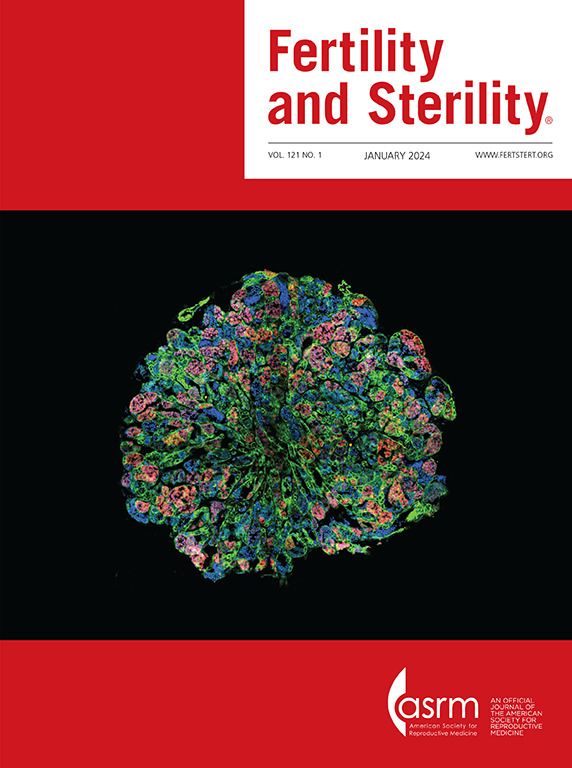Vitamin D levels in couples undergoing in vitro fertilization treatment: lack of association with embryo quality or pregnancy rates
IF 7
1区 医学
Q1 OBSTETRICS & GYNECOLOGY
引用次数: 0
Abstract
Objective
To investigate the potential impact of vitamin D (VD) serum levels on couples going through in vitro fertilization treatment in terms of embryo quality and pregnancy rates.
Design
A retrospective cohort study.
Setting
A private human reproduction center.
Patient(s)
A total of 267 couples underwent intracytoplasmic sperm injections between January 2017 and March 2019.
Intervention(s)
The couples were categorized into four groups on the basis of 25-hydroxy VD (25OHD) levels measured at the beginning of the stimulation protocol: group 1 with 25OHD levels ≥30 ng/mL for both women and men; group 2 with 25OHD levels <30 ng/mL for both; group 3 women with 25OHD levels <30 ng/mL and men with 25OHD levels ≥30 ng/mL; and group 4 with women with 25OHD level ≥30 ng/mL and men with 25OHD level <30 ng/mL.
Main Outcome Measure(s)
We consider the quantity and quality of embryos during the cleavage as well as blastocyst stages as primary outcomes. Correspondingly, the clinical pregnancy rate (CPR) was regarded as a secondary outcome.
Result(s)
Our findings revealed no significant correlations between the studied VD groups and the evaluated outcomes. This includes the quantity and quality of embryos during the cleavage and blastocyst stages, as well as the CPR. Primary analysis revealed a small but statistically significant difference in the duration of controlled ovarian stimulation between group 1 and group 2 (95% confidence interval, 0.07–3.04) and between group 1 and group 3 (95% confidence interval, 0.05–3.23).
Conclusion(s)
The present study found no correlation between the studied VD levels and the quantity as well as quality of cleavage or blastocyst stage embryos, nor did it show any impact on CPRs. Further well-designed, prospective studies are warranted to determine whether and how vitamin D affects reproductive outcomes.
Niveles de vitamina D en parejas sometidas a tratamiento de fecundación in vitro: falta de asociación con la calidad del embrión o las tasas de embarazo
Objetivo
Investigar el impacto potencial de los niveles séricos de vitamina D (VD) en parejas que se someten a un tratamiento de fertilización in vitro en términos de calidad embrionaria y tasas de embarazo.
Diseño
Estudio de cohorte retrospectivo.
Lugar
Centro privado de reproducción humana.
Paciente(s)
Un total de 267 parejas se sometieron a inyecciones intracitoplasmáticas de espermatozoides entre enero de 2017 y marzo de 2019.
Intervención(es)
Las parejas se clasificaron en cuatro grupos en función de los niveles de 25-hidroxi VD (25OHD) medidos al inicio del protocolo de estimulación: grupo 1 con niveles de 25OHD ≥ 30 ng/mL tanto para mujeres como para hombres; grupo 2 con niveles de 25OHD <30 ng/mL para ambos; grupo 3 mujeres con niveles de 25OHD <30 ng/mL y hombres con niveles de 25OHD ≥ 30 ng/mL; y grupo 4 con mujeres con nivel de 25OHD ≥ 30 ng/mL y hombres con nivel de 25OHD <30 ng/mL.
Principales medidas de resultado
Consideramos la cantidad y calidad de embriones durante la división, así como las etapas de blastocisto, como resultados primarios. En consecuencia, la tasa de embarazo clínico (CPR) se consideró como un resultado secundario.
Resultado(s)
Nuestros hallazgos no revelaron correlaciones significativas entre los grupos de VD estudiados y los resultados evaluados. Esto incluye la cantidad y calidad de embriones durante las etapas de división y blastocisto, así como la CPR. El análisis primario reveló una pequeña pero estadísticamente significativa diferencia en la duración de la estimulación ovárica controlada entre el grupo 1 y el grupo 2 (intervalo de confianza del 95 %, 0.07–3.04) y entre el grupo 1 y el grupo 3 (intervalo de confianza del 95 %, 0.05–3.23).
Conclusión(es)
El presente estudio no encontró correlación entre los niveles de vitamina D estudiados y la cantidad y calidad de los embriones en etapa de división o blastocisto, ni mostró impacto alguno en las tasas de reproducción asistida. Se justifican estudios prospectivos bien diseñados adicionales para determinar si la vitamina D afecta los resultados reproductivos y de qué manera.
体外受精夫妇的维生素 D 水平:与胚胎质量或妊娠率无关
目的:研究维生素 D 血清水平对试管受精夫妇胚胎质量和妊娠率的潜在影响:调查维生素 D 血清水平对试管受精夫妇胚胎质量和妊娠率的潜在影响:设计:回顾性队列研究:受试者:2017年1月至2019年3月期间接受卵胞浆内单精子注射的267对夫妇。暴露:根据刺激方案开始时测量的25OH维生素D水平,将夫妇分为四组:第1组,男女双方水平均≥30纳克/毫升;第2组,男女双方水平均<30纳克/毫升;第3组,女性<30纳克/毫升,男性≥30纳克/毫升;第4组,女性≥30纳克/毫升,男性<30纳克/毫升.主要结果测量:我们将分裂期和囊胚期胚胎的数量和质量作为主要结果。相应地,临床妊娠率被视为次要结果:结果:我们的研究结果表明,所研究的 VD 组与评估结果之间没有明显的相关性。结果:我们的研究结果表明,所研究的 VD 组与评估结果之间没有明显的相关性,包括胚胎在分裂期和囊胚期的数量和质量,以及临床妊娠率。初步分析显示,第 1 组和第 2 组(P=0.035;CI=0.07 - 3.04)以及第 1 组和第 3 组(P=0.040;CI=0.05 - 3.23)之间的控制性卵巢刺激持续时间差异较小,但具有统计学意义:本研究发现,所研究的 VD 水平与卵裂期或囊胚期胚胎的数量和质量之间没有相关性,对临床妊娠率也没有任何影响。有必要进一步开展精心设计的前瞻性研究,以确定维生素 D 是否以及如何影响生殖结果。
本文章由计算机程序翻译,如有差异,请以英文原文为准。
求助全文
约1分钟内获得全文
求助全文
来源期刊

Fertility and sterility
医学-妇产科学
CiteScore
11.30
自引率
6.00%
发文量
1446
审稿时长
31 days
期刊介绍:
Fertility and Sterility® is an international journal for obstetricians, gynecologists, reproductive endocrinologists, urologists, basic scientists and others who treat and investigate problems of infertility and human reproductive disorders. The journal publishes juried original scientific articles in clinical and laboratory research relevant to reproductive endocrinology, urology, andrology, physiology, immunology, genetics, contraception, and menopause. Fertility and Sterility® encourages and supports meaningful basic and clinical research, and facilitates and promotes excellence in professional education, in the field of reproductive medicine.
 求助内容:
求助内容: 应助结果提醒方式:
应助结果提醒方式:


